
APRA recently released its latest annual results on the performance (for year ending June 2011) of non-self managed superannuation funds, i.e the retail, industry and corporate super funds, which represent about 2/3rds of total superannuation “savings”.
Strikingly, the value and number of self-managed super funds (SMSF) has increased, the latter by 7.2% whilst the remaining decreased by 9.8%, leaving this sector the biggest of all (labelled as small in the chart below, since by definition a self managed fund cannot have more than 4 members):
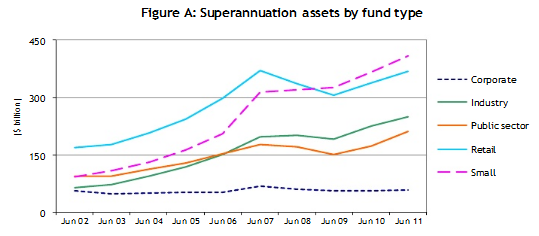
The 1 year performance results to June 2011 were very good, up 7.8% across all types, with industry super funds outperforming – up 9% for the year – against the retail funds, with a very poor relative performance of 6.5% for the year. For reference over the same time period, the ASX200 gained about 300 points, rising from 4300 to 4600 during this time, or just over 7% – before falling another 13% at its nadir to recovering to where it started nearly 2 years ago…
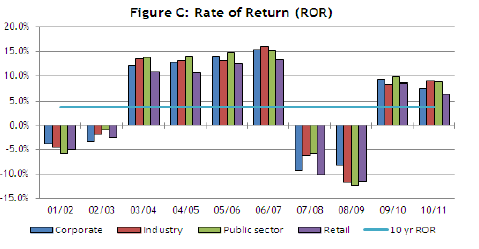
Here is the latest update (end of February) as provided by SuperRatings – note that one year returns in the default “balanced” funds are 0.1%, or around 5-8% below the 3 and 10 year averages, whilst diversified fixed interest and cash returns are 8.2% (largely because of the rally in Australian bonds which I spoke about here) and 4.3% respectively, roughly the same as every rolling period going back 10 years:

To put this in context using the APRA results for an average fund, since the GFC, a $100,000 portfolio (assuming no further contributions) would still have been reduced to $95,400 even after two solid years of performance (the previous year was 8.9% for all funds).
The 15 year average rate of return (ROR) has been 5.2% p.a or just 2.5% p.a after inflation (in real terms), but as we shall see shortly, its the variability of this return that should have you quite concerned.
Volatility in super is risky
This report has a fascinating special section on the volatility of returns, encompassing 15 years of quarterly and annual data. This is quite important to understand, from both a macro and individual level – you see, whilst 25% of superannuation accounts are held by those about to retire (i.e over 50 years of age), this cohort comprises some 60% of account balances.
If this cohort (and the similar sized Gen X that follows) sees even a modest correction in their super, the actual amount of spending (i.e aggregate demand) they can do whilst in retirement will affect the entire economy. In addition, if they have to save more in the later years of their working life to make up this loss, this also has an immediate and instant impact due to the delayed consumption.
This summary is telling:
The average industry-wide ROR (rate of return) for the most recent five-year period was lower than the two preceding five-year periods and the volatility of quarterly industry-wide RORs was higher than the two preceding five-year periods. Increased volatility of superannuation RORs leads to greater uncertainty around members’ final retirement outcomes.
There were also more frequent negative returns in the most recent five-year period compared with the two preceding five-year periods.
This chart explains the conundrum with the volatility inherent in superannuation – obviously the good time to retire was 2004-2007, but what to do with your pension thereafter?
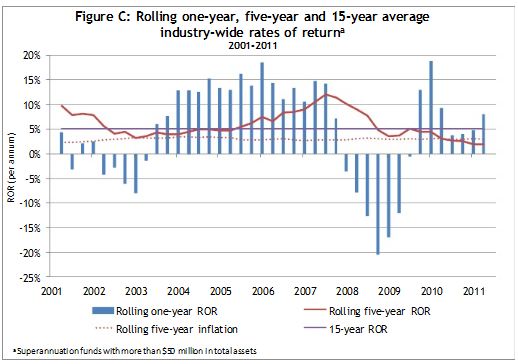
The report compared the rolling 5-year industry wide annual rate of return (ROR) to a one year rolling return, with the latter varying between -20.5% and plus 18.7% p.a, whilst the former varied at plus 1.9% to 12% per annum. Notably, the current five year rolling ROR, at 1.9% p.a, is less than the average inflation rate over the same period – which means the average super fund (either in accumulation or pension phase) has seen a decrease in purchasing power.
Further, the volatility of these returns has been increasing over time, and not just since the GFC, but from the mid-1990s onwards. The culprit? A slavish devotion to allocation in shares and a disdain for that big bad bugaboo – bonds:
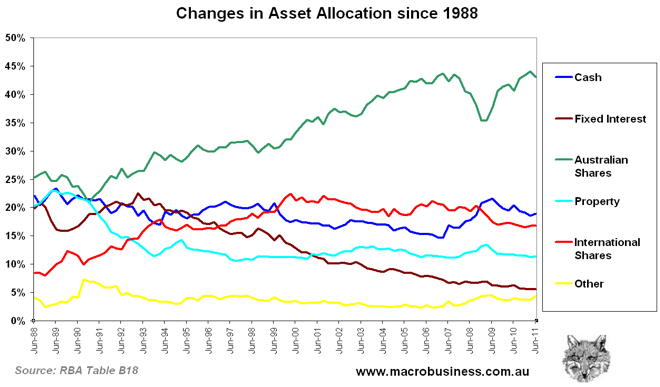
Its the allocation and risk management that matters
I’ve talked about this a lot since I started blogging at MacroBusiness. I’ve gone over the concept of how the average returns quoted by the vested interests of the financial investment industry gloss over the volatility that can turn your retirement dreams sour.
I’ve explained my preferred solution – one based on the concept of absolute returns, not relative returns as used by the mainstream investment industry – which means obtaining constant positive returns, the upside “clipped” by hedging the downside, but aiming to never make a loss.
Paradoxically, this solution works for both the near-retiree, who needs to both protect his large amount of savings from capital loss and declining purchasing power, and the young accumulator, where although losses can be recouped due to the vagaries of time, the opportunity cost of this permanent loss can be massive.
This table reinforces my contention that the reason behind the poor average performance and exceedingly high volatility is asset allocation:
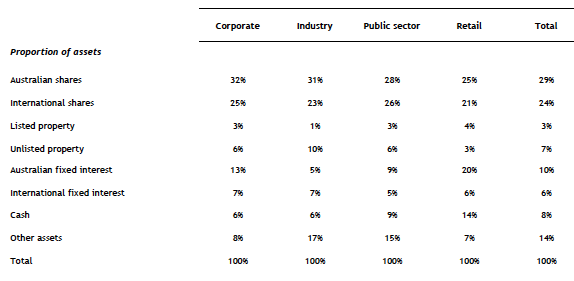
The report notes that 42% of all funds have their members in the “default” settings listed above, sometimes called “balanced”, even though nearly 70% is in “growth” assets. This is the euphemistic term for assets that rely upon volatility to make a return, i.e they require capital gain, not a flow of steady income, to actually work. In other words, speculation.
Is this the right vehicle to save for your retirement? Why have we decided that super is a place to speculate when someone looking from Mars would say – hang on, isn’t it just a savings account?
Indeed. There are macro and micro questions left unanswered to why this remains the case, and why the super funds (both for-profit retail and “non-profit” industry) have not come up with any answers or solutions. I’ll ask those questions in my next post.